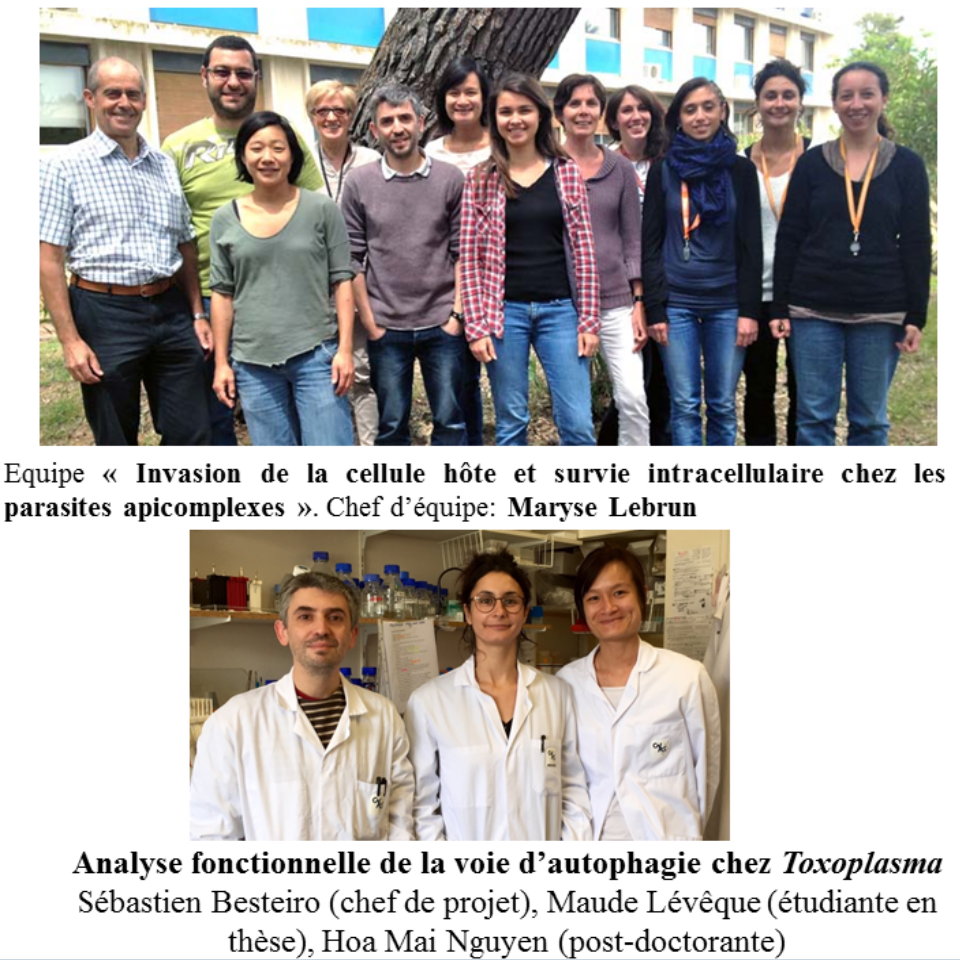Functional analysis of the autophagy pathway in Toxoplasma
DIMNP, UMR 5235 CNRS, Université de MontpellierPlace Eugène Bataillon
CC 107
34095 Montpellier cedex 5
France - Montpellier
Site web - sebastien.besteiro@inserm.fr -
Principal investigator
Sébastien Besteiro

Research themes
Toxoplasma gondii is a ubiquitous parasitic protozoa that infects up to 30% of the World’s population and causes a disease that, although generally benign, can prove fatal. This is particularly the case for a developing foetus (when the mother becomes infected during pregnancy) or for immunocompromised people.
As its mammalian intermediate hosts, this unicellular parasite is a eukaryote, but they are very distant phylogenetically. We are focusing on essential cellular processes, which are thus usually conserved among eukaryotes, but bearing enough differences to make them potential therapeutic targets in the parasites.
Autophagy is a reparative and life-sustaining process by which cytoplasmic components are sequestered in double-membrane vesicles called autophagosomes, and degraded after fusion with a degradative lysosomal compartment. T. gondii is an obligate intracellular parasite possessing an apparently reduced autophagy machinery. It is nevertheless able to generate vesicles resembling autophagosomes (with double membrane, decorated with TgATG8,…) upon stress such as starvation (A). However, the canonical autophagic pathway is not completely characterised in these parasites as degradation and recycling of autophagosomes has not been clearly demonstrated yet. We are currently undertaking the functional characterisation of early players in the autophagy pathway (ie protein TgATG9) to evaluate their involvement in canonical autophagy and the importance of this pathway for the parasites in sustaining stress.
We have also recently shown that, in T. gondii, the TgATG8-centered part of the autophagy machinery has been repurposed for an original function in maintaining the homeostasis of an organelle called the apicoplast (B). This is a non-photosynthetic plastid which is essential for the survival of the parasites. As such, it is a privileged target for discovering novel therapeutic strategies. We are thus currently trying to understand why and how this ancient eukaryote has been repurposing part of the autophagy machinery for new original functions which are crucial for its cellular homeostasis.
Par ailleurs, nous avons également récemment montré que chez T. gondii la partie de la machinerie d’autophagie, centrée autour de la protéine TgATG8, est réorientée vers une fonction originale, pour la réplication et le maintien d’une organelle appelée l’apicoplaste (B). C’est un plaste non photosynthétique, mais qui est essentiel à la survie du parasite. En tant que tel, c’est une cible privilégiée pour la recherche de nouvelles voies thérapeutiques. Nous cherchons donc à comprendre comment et pourquoi cet ancien eucaryote a détourné une partie de la machinerie d’autophagie pour de nouvelles fonctions originales ayant des implications fondamentales pour son homéostasie cellulaire.
Descriptive figure

Publications
-Autophagy in Toxoplasma gondii and its host cells. Besteiro S. In « Toxoplasma gondii/host cell interactions: recent advances ». Mercier C and Delauw M-F (Eds.) Bentham eBooks. 2016. In press. Book chapter
-Unusual functions for the autophagy machinery in apicomplexan parasites. Lévêque M, Besteiro S. In « Autophagy: Cancer, Other Pathologies, Inflammation, Immunity, and Infection. Vol.9 ». Hayat MA (Ed.). Elsevier Academic Press. 2016. In press. Book chapter
-Autophagy-related protein ATG8 has a noncanonical function for apicoplast inheritance in Toxoplasma gondii .Lévêque MF, Berry L, Cipriano MJ, Nguyen HM, Striepen B, Besteiro S. (MBio. 2015;6(6):e01446-15) doi: 10.1128/mBio.01446-15.
-Autophagy in parasitic protists. Besteiro S. In « Autophagy: Cancer, Other Pathologies, Inflammation, Immunity, and Infection. Vol.2 ». Hayat MA (Ed.). Elsevier Academic Press. 2014. Book chapter
-Regulation of ATG8 membrane association by ATG4 in the parasitic protist Toxoplasma gondii. Kong-Hap MA, Mouammine A, Daher W, Berry L, Lebrun M, Dubremetz JF, Besteiro S. (Autophagy. September 2013;9(9):1334-48)
-Which roles for autophagy in Toxoplasma gondii and related apicomplexan parasites? Besteiro S. Review. (Molecular & Biochemical Parasitology. July 2012; 184 (1): 1-8) Review
-Role of ATG3 in the parasite Toxoplasma gondii: Autophagy in an early branching eukaryote. Besteiro S. (Autophagy. March 2012 .8(3): 435-437) Commentary
-Autophagy protein Atg3 is essential for maintaining mitochondrial integrity and for normal intracellular development of Toxoplasma gondii tachyzoites. Besteiro S, Brooks CF, Striepen B, Dubremetz JF. (PLoS Pathogens. December 2011. 7(12): e1002416)
Composition de l'équipe
Hoa Mai Nguyen, Post-doctorante, thi-hoa-mai.nguyen@univ-montp2.fr
Maude Lévêque, Doctorante, maude.leveque@univ-montp2.fr